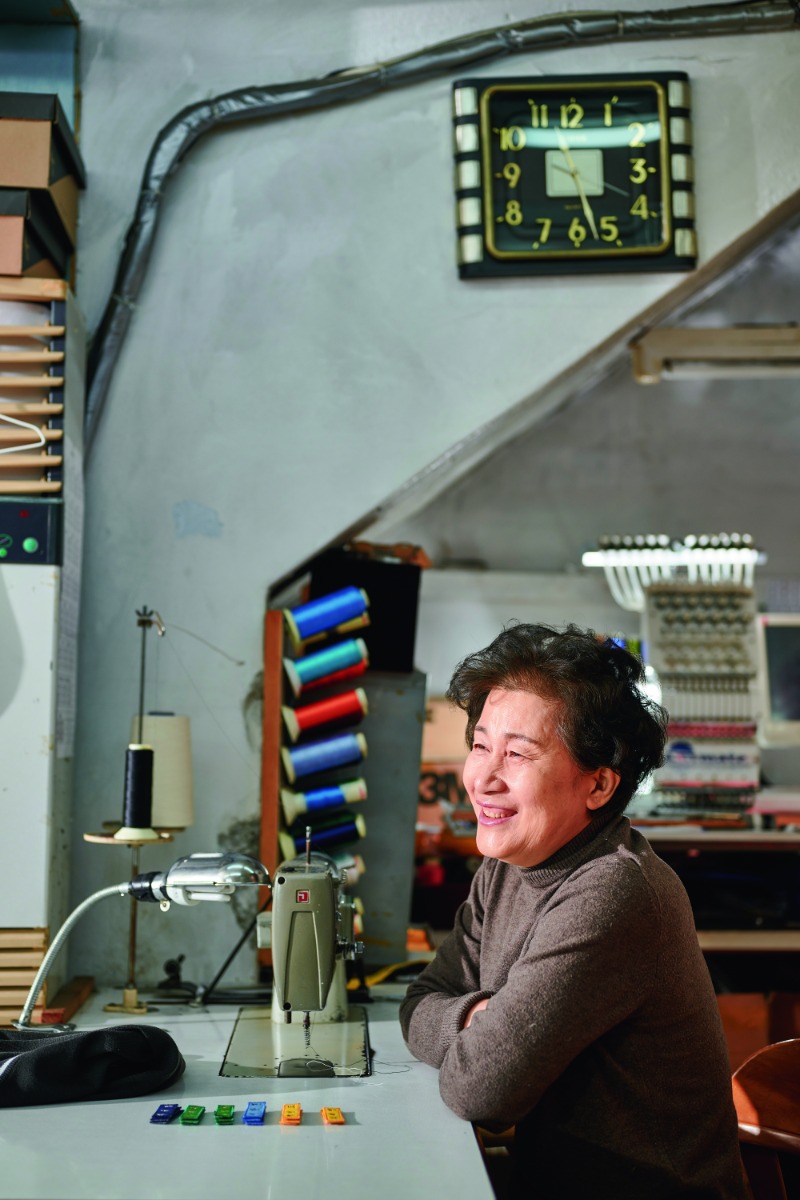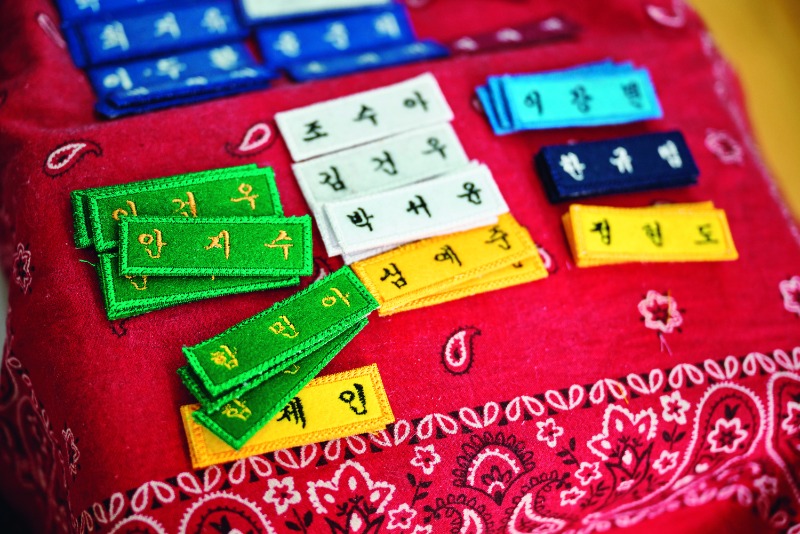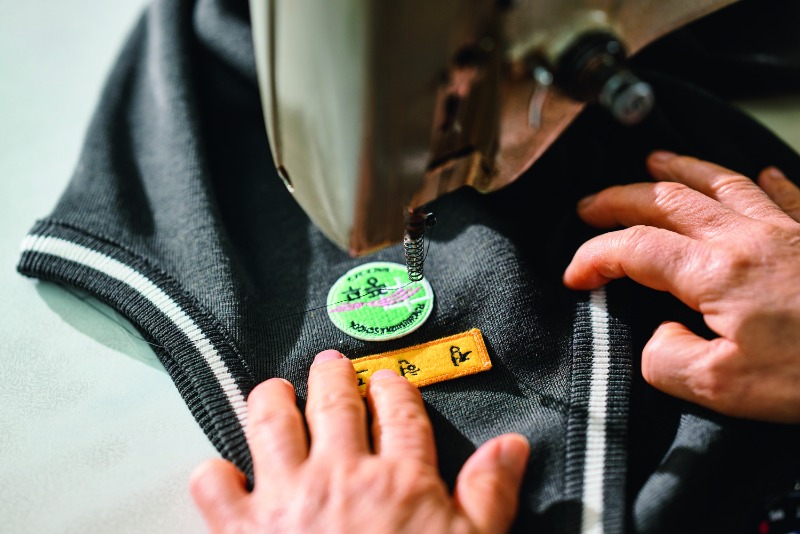Lee Kyeong-ja has embroidered name tags on school uniforms for so long that her first generation of student-customers now bring their children’s clothes to her. Her days at the sewing machine in her sporting goods store are nearing an end, though.

For the past 40 years, Lee Kyeong-ja has been opening her shop every morning. Some of her student-customers from long ago now bring their children to have their name tags sewn by her
“Done in a flash” infers astonishing, effortless speed and efficiency. That would describe Lee Kyeong-ja at work. When she embroiders a name tag onto a uniform, she is finished in less than sixty seconds. She manipulates her sewing machine in a flash, but the time needed to achieve such speed was anything but short. Starting with mastering a straight line, countless hours ensued.
All of Lee’s fingers are slightly bent in one direction, evidence of 40 years of carefully embroidering names into cloth at her store, Gim-il Sporting Goods, in Gimpo, Gyeonggi Province. “When I first started working with a sewing machine, I hurt my hands a lot. Now, of course, I have aches and pains in my fingers and wrists. Still, I think it was fairly happy work. When you’re running a sewing machine, you see, you don’t really think about anything else. Sometimes, when we’re really busy, I even forget to eat. Time truly flies,” she says.
NUMBERED DAYS

Gim-il Sporting Goods is always busiest in January and February, when students bring their uniforms to have their names embroidered before the school year begins.
Gim-il Sporting Goods is in Bukbyeon-dong, Gimpo, at the mouth of the Han River, a 25-minute drive from Seoul. Previously the bustling center of the city, Bukbyeon-dong had Gimpo’s first district hall and post office in the 1970s. A bevy of shops, bars, and cafés followed.
Today, the area is slated for redevelopment. The familiar old sights and sounds of the neighborhood are scheduled to completely disappear within a few years.
“Once the neighborhood gets torn down, I’m planning to close the store. Our monthly rent is currently 500,000 won (around US$400), but if we move someplace new, we will have to pay double or triple or even more. We can’t handle that with our current income. Now that I know my days in this job are numbered, I feel that much more grateful to each customer who gives us their business,” Lee says.
Students from some twenty middle and high schools in Gimpo supply a steady stream of potential customers. The name tags for each grade differ from school to school, of course. To stay up to date, Lee attaches notes to the colors of her threads — school, new student, returning student, and so on — and puts them on the wall for quick reference.
Like Spinoza, determined to plant his apple tree despite the world ending tomorrow, Lee sits at her sewing machine, quietly embroidering name after name. She can also thread a needle in the blink of an eye. This isn’t because she has good vision; it’s the muscle memory in her fingers.
With her sewing machine Lee replicates gungseo, a font based on the flowing, elegant calligraphy produced by court ladies during the Joseon Dynasty that was commonly used for formal documents. Made by hand, the name tags may have tiny differences. Knowing that the tags have a human touch gives them a sense of warmth, which cannot be replicated on the computerized embroidery machine that Lee’s younger brother operates.
THREE BEATS
Lee is the third owner of Gim-il Sporting Goods. She took over in 1983 from a high school classmate whose father founded the businesses. Changing the name of the store was out of the question. It stands for “number one sporting goods store in Gimpo.” (“Gim” is short for Gimpo and “il” means “one” in Korean.) “I liked that meaning a lot, so we kept the name as is,” Lee recalls.
Sporting goods stores near schools not only sell equipment but also sports uniforms. They initially provided an embroidered name tag as a freebie for loyal customers. Eventually, all the students expected the same and the stores realized they had another potential revenue source. They started making name tags for all school uniforms. Lee charges 2,000 won (less than US$2) for an embroidered name tag. Some may say this is far too cheap, and others may think it a bit pricey. In any case, Lee does not quibble. She just smiles and keeps sewing.
“In the early days, we would take the school uniforms and gym uniforms we sold here to another shop to get names embroidered, because I didn’t know how to do it myself. But it wasn’t sustainable, so I began to learn and practiced whenever I could,” Lee explained.
“My sewing machine was with me always, from early in the morning to late at night. I think it took about six or seven years before I felt confident about sewing the names myself. Embroidering with a sewing machine isn’t just about using your hands — you need to control the speed with your feet by pressing the pedal, and push the knee lift to control the thickness of each letter. It’s three beats that have to line up, so it takes a long time to become skillful at it.”
Some of Lee’s student-customers have returned years later to ask for name tags for their own children. At those moments she is glad she has stayed put for so long. These days, a lot of mothers of kindergarteners have also started getting their children’s names embroidered on their handkerchiefs and uniforms. Even though Lee has never seen the tots in person, she finds herself smiling as she sews their names.
KEEPING TIME

Having sewn so many names over the years, Lee recognizes what names are popular. Some names have up to five-characters, unlike the usual three.
Lee, 69, starts at the crack of dawn. She opens her store at 10 a.m. and closes at 6 p.m. From her seat, Lee stays attuned to what names are popular. “For a while, it was Korean names without Chinese-character roots. These days, it seems to be names that are more unisex. I’ve embroidered four-character names that use both parents’ last names, and I’ve embroidered names that are five characters long. Looking back now, they’re all happy memories,” she explains.
From the 1970s through the mid-1980s, the early years of her store, the Gimpo area had abundant empty, flat areas. Winters were colder then, keeping rice paddies frozen and making ice skates a big seller. After winter, roller skate sales picked up. Of course, there are steady sellers regardless of fads and seasons, such as table tennis and badminton racquets, footballs, and basketballs. Whatever the fad, Lee liked the fact that she was selling things that helped children run and play and be healthy.
Nowadays, sales have plunged due to internet shopping. The sewing service has become a primary revenue generator. In addition to school uniforms, name tags for work clothes are embroidered, and an increasing number of people come to have patches sewn on their clothes, simply because they don’t know how to sew by themselves.
“When a customer wants a patch to cover a hole in their garment, sometimes I’ll just sew them a design in the shape of a rose or a leaf,” Lee says. “It looks better to sew a design with thread in the same color as the garment rather than attaching a patch that’s actually a different material. The customers like it, too, which makes me feel good.”
In addition to Lee’s store, there is another sporting goods store in the neighborhood: Gimpo Sporting Goods. This place also offers embroidery services, but the two stores are not exactly fierce rivals. For example, before a new school year, they calculate how many gym uniforms the local schools will need, and each store will order half the amount. If one store sells out first, they will direct customers to the other store. Everyone has learned through experience that the secret to the long haul is in helping each other out.
The same can be said in regard to Lee’s children. Before moving to its current location in 1992, Gim-il Sporting Goods occupied what used to be Upare Theater, once Gimpo’s only movie theater. The family lived above the store and Lee raised her two children there with the help of neighbors. It was difficult to work full-time and be a mother, but these days Lee finds herself waxing nostalgic about it all, especially how the whole neighborhood was so full of warmth.
“I was born in Yangchon-eup in Gimpo, and Gimpo is where I attended elementary, middle, and high school. I married my high-school sweetheart, and I still live in Gimpo to this day. When I was young, there was nothing here but farmland. Autumn was always so beautiful, the rice fields ripened to gold. As the city grew, the atmosphere of those old days disappeared, but I still have all the warm memories in my heart,” she reminisces. “I want to keep on living right here until the day I die.”
Park Mi-kyeong Freelance Writer
Han Jung-hyun Photographer